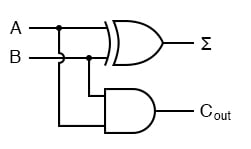As a first example of useful combinational logic, let’s build a device that can add two binary digits together. We can quickly calculate what the answers should be:
0 + 0 = 0 0 + 1 = 1 1 + 0 = 1 1 + 1 = 102
So we will need two inputs (a and b) and two outputs. The low order output will be called Σ because it represents the sum, and the high order output will be called Cout because it represents the carry out. The truth table is:
| A | B | Σ | Cout |
| 0 | 0 | 0 | 0 |
| 0 | 1 | 1 | 0 |
| 1 | 0 | 1 | 0 |
| 1 | 1 | 0 | 1 |
Simplifying boolean equations or making some Karnaugh map will produce the same circuit shown below, but start by looking at the results. The Σ column is our familiar XOR gate, while the Cout column is the AND gate. This device is called a half-adder for reasons that will make sense in the next section.

or in ladder logic

RELATED WORKSHEET:

In Partnership with Renesas Electronics

by Aaron Carman

by Robert Keim

by Duane Benson
